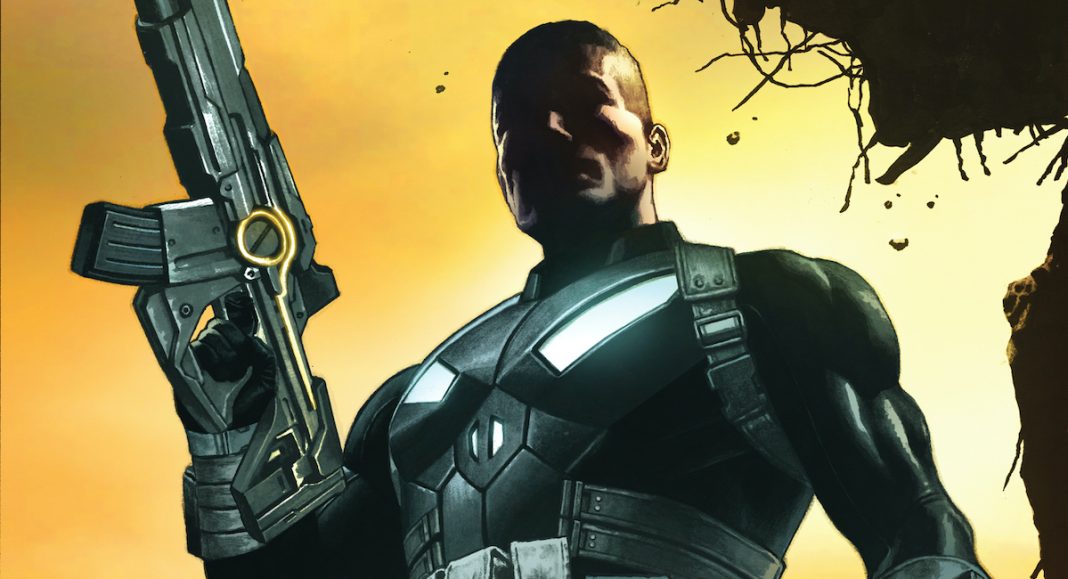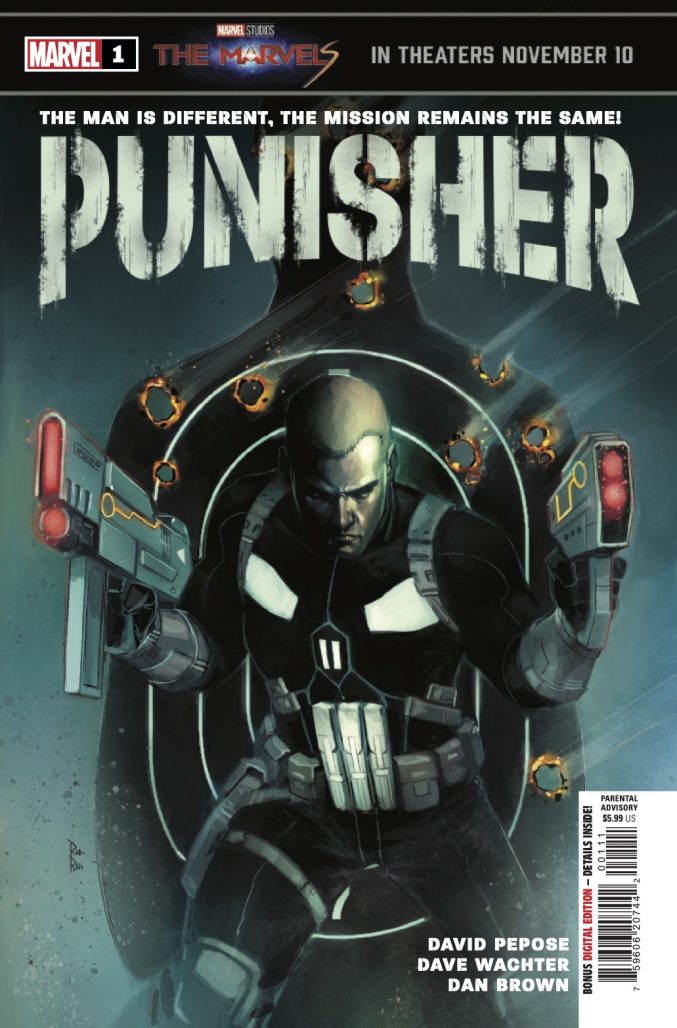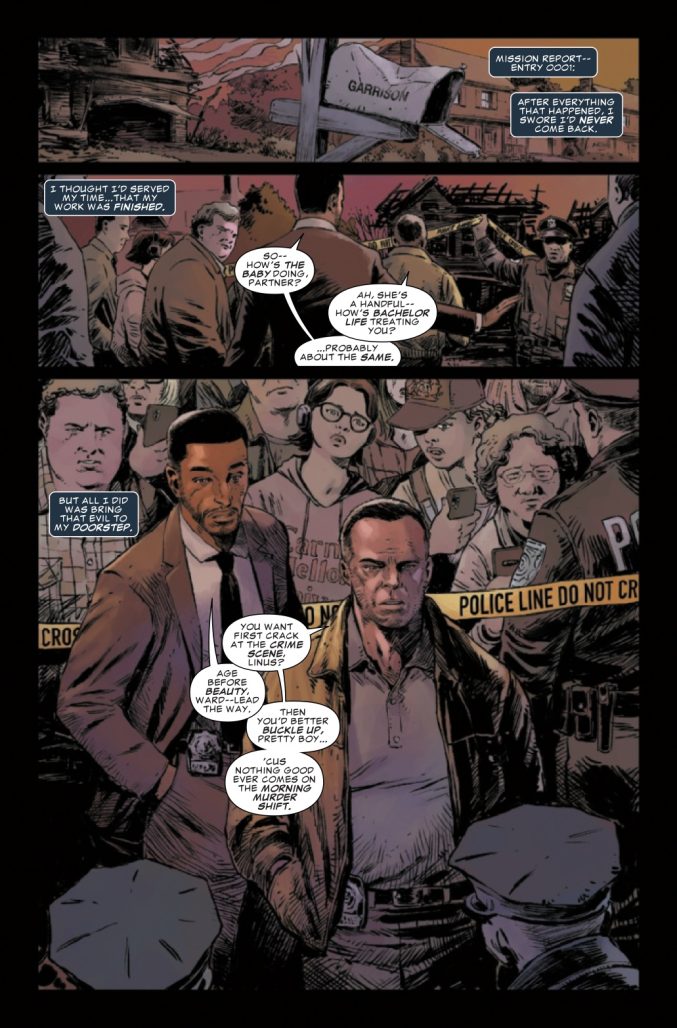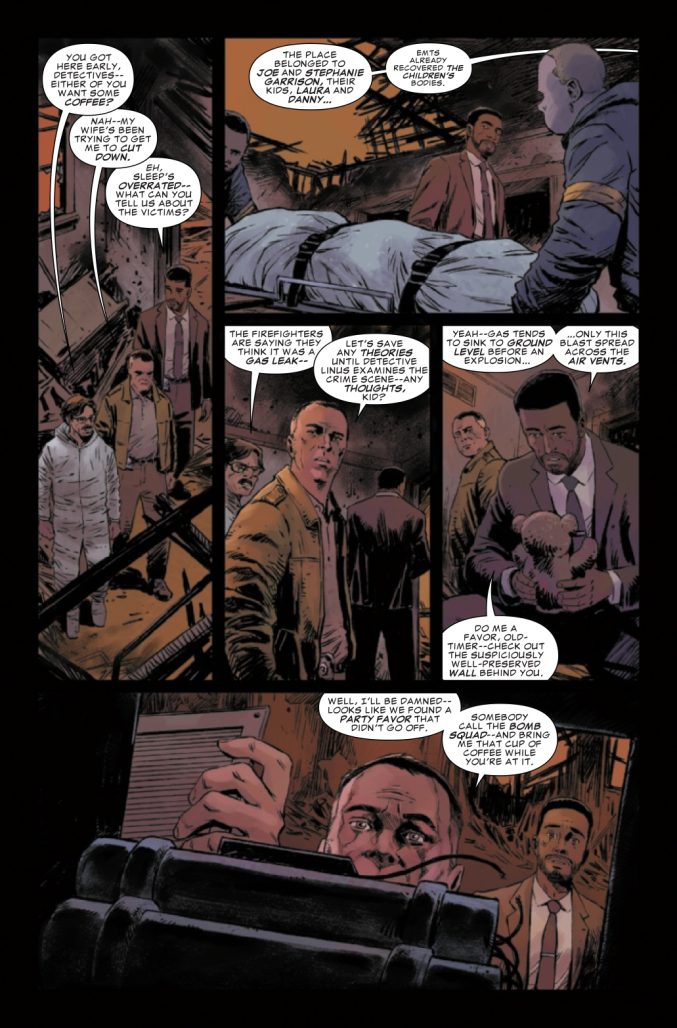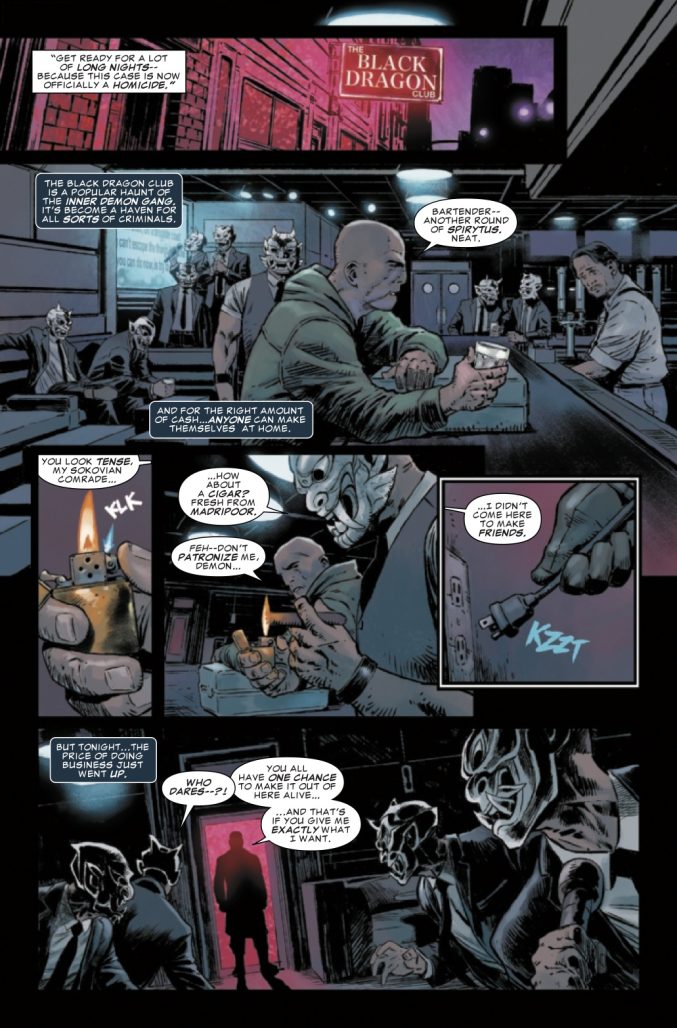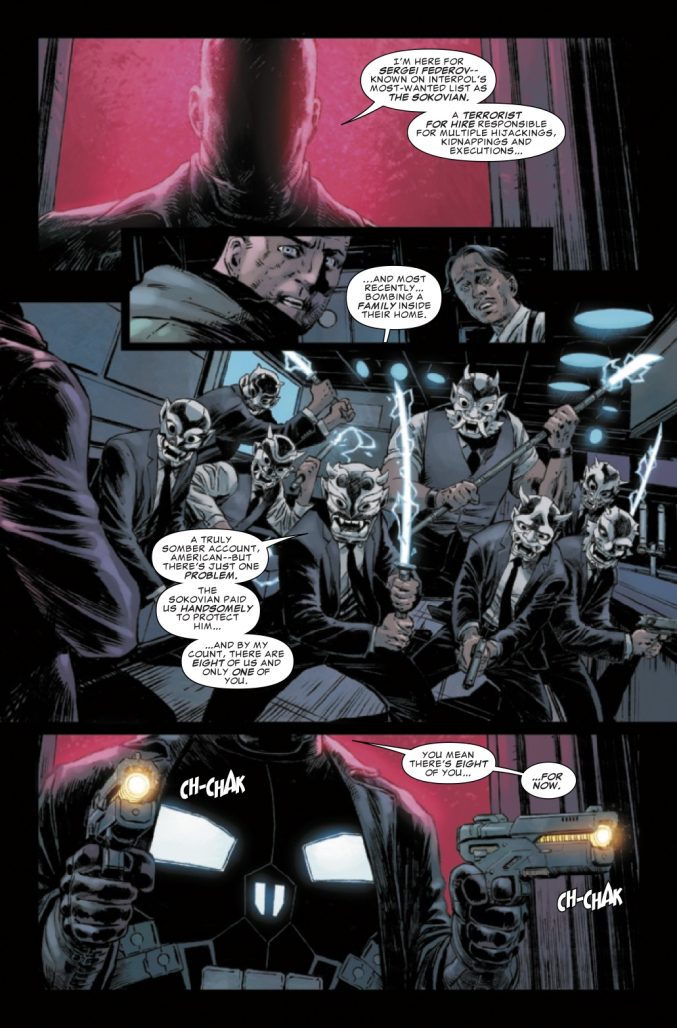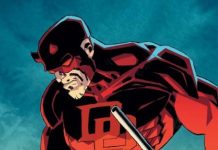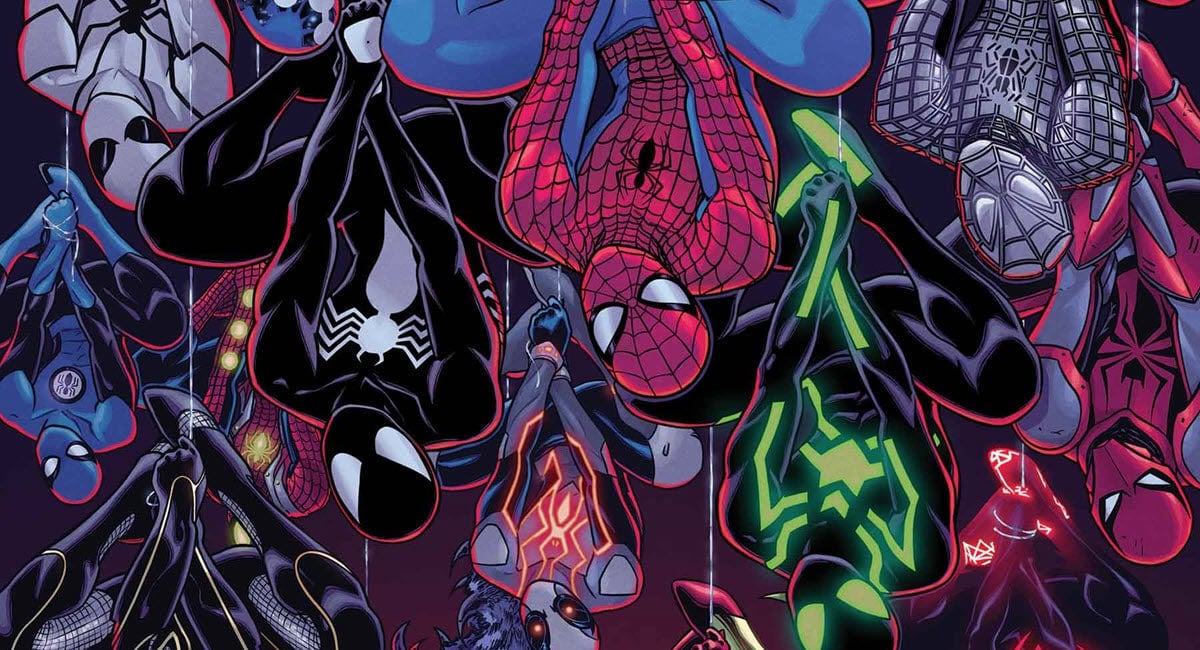This week sees the release of The Punisher #1 from Marvel Comics. With Frank Castle having disappeared, the all-new ongoing series introduces a new character to the mantle of The Punisher, Joe Garrison, a former S.H.I.E.L.D. agent who puts his very particular set of skills to use following the deaths of his family.
The new Punisher series comes from the creative team of writer David Pepose, artist Dave Wachter, and colorist Dan Brown. For Pepose, The Punisher is the writer’s latest Marvel work. Pepose is also writing the current Moon Knight: City of the Dead miniseries and previously wrote, among other things, the second iteration of Savage Avengers, which included an arc featuring the Punisher of 2099.
The Beat caught up with Pepose to talk the origins of Joe Garrison, the character’s connection to the larger Marvel Universe, and the politics of The Punisher in 2023. Check out that interview, along with a preview of this week’s The Punisher #1, below.
Joe Grunenwald: Joe Garrison is the new Punisher. That’s also my first name and the name of the street where I grew up. What are you doing? What are you doing to me?
David Pepose: You know, we did this specifically for you. So I’m glad that you noticed.
Grunenwald: Is his sidekick going to be my mother’s maiden name and the last four of my social security number, ’cause I need to know.
Pepose: I think I’m going to need that just for confirmation’s sake. So, yeah, just feel free to send that to me. And don’t pay any attention to your bank account for another week.
Grunenwald: You’re going to be disappointed by what you find there.
What can you tell me about Joe? What is his life like before he becomes The Punisher? You’ve said elsewhere that he’s an ex-SHIELD agent who has become a family man. But what’s his personality like?
Pepose: Joe is the kind of guy who’s kind of buried the past, and unfortunately, nothing really stays buried forever. He wasn’t just a SHIELD agent, he was a SHIELD wetworks agent, Black Ops. He was tasked with performing all sorts of lethal business as the Gravedigger of SHIELD. And over the course of his career, he found another way to take his life, another path forward, and that was the path of family, the path of peace. And so what winds up happening is, somebody blows up Joe’s house with his family still inside. The police, not knowing anything about Joe’s record, because it’s been so heavily redacted, they think, ‘Well, we can’t find the husband, the husband must be involved. He’s a person of interest at minimum, prime suspect at best, we need to bring him in.’ And so I’ve pitched this Punisher series as John Wick meets The Fugitive, where Joe’s opening mission, and sort of our origin story with him, is him trying to figure out who set him up and why.
And so much of the story also is about – I know there’s been a lot of questions about The Punisher and whether or not that can be a legacy. I kind of refute that question, having written Punisher 2099 in Savage Avengers and being familiar with characters like Rachel Cole-Alves, who I love, and Lynn Michaels, even Jigsaw himself was the Punisher for a short period of time. But with that all being said, it’s not always a legacy you choose. Sometimes it’s a legacy that finds you, and that’s going to be a big part of the throughline of this opening arc. It’s going to be Joe figuring out, what starts off as a standalone mission, how do the parameters change? How does this morph into something bigger and more long-term? In other words, how does this mission become a war? It’s been really fun to be able to explore this character and kind of get to really get a sense of who he is.
I think the biggest difference that I would say between Frank Castle and Joe Garrison is, by the time you meet Frank in Amazing Spider-Man #129, he’s already been the Punisher, he’s already made that decision. He’s marinated in that pain and that loss long enough to make a decision, and he’s been doing it seemingly for a little while. In this series, we can get to watch Joe, in the moment, as he’s coming to terms with all of this. The wound is still fresh for him, very fresh, and that’s sort of how his methodology starts to evolve over the course of the series. It’s a lot of blue-sky thinking, and that’s a fun opportunity with a legacy character. You figure out what parts are core to a character that you have to keep in order to make them viable, and to make them still ring true as The Punisher, or whatever legacy character you’re talking about, versus what elements can we tweak? You know, like how Robbie Reyes managed to pivot Ghost Rider from motorcycle culture to muscle car culture.
In this case, Joe, instead of taking the Death Wish route, we’re going the John Wick route, which is focusing on the gun fu of it all. We’re not focusing as much on the hardware as much as the choreography that it’s being used with, Joe’s ability to weave through crowds of people with his SHIELD guns – which have bullets, they are lethal, just in case anybody’s wondering. But also, [it’s about] the choreography of it and also being able to use his environment as improvisation. So trust me, this Punisher is going to have a body count. Don’t worry too much about that. But the other thing is, there are some punishments worse than death. And so that is kind of my long term goals for Joe, is to give him a rogue’s gallery of people who, some people are going to just die on the first attempt, but some, if they live for round 2, they’re going to regret it in a real, permanent way.
Grunenwald: You’ve said that Tom Brevoort came to you and said they were wanting to introduce a new Punisher. How much collaboration or how much input did you have in coming up with Joe’s backstory?
Pepose: I love working with Tom Brevoort, I’ve worked with him on the majority of my work at Marvel. I can’t say enough good things about him. He’s like a perfect tennis partner, [and] we really play off each other in a fun way. This was the most development that Tom and I have ever done on a series together. We spent the better part of two months really going back and forth, pitching different ideas of how to get this Punisher across in a way that stands out on his own, but that also, you know, reads responsibly in the year 2023, and also can fit in a runway. We didn’t want this origin arc to drag on so long that it overstayed its welcome. We wanted it to be nice and tight and punchy.
There was a lot of collaboration also with Dave Wachter, the artist on the book. Dave is really instrumental in the visual vocabulary that we’re using in this, in the way that Joe kind of moves in any particular scene, but also the design. Dave did a really cool job of taking what seems like a recognizable Punisher look, but doing something very different with it that stands on its own. It’s unique. So yeah, it was a big jam band session with all of us. Once we finished hammering the whole thing out, we had a really cool idea for Punisher both in terms of an origin, but also [in terms of] a vehicle for him moving forward for further adventures, and sort of his storytelling engine.
Grunenwald: As a former SHIELD agent, does Joe have any connections to other existing Marvel heroes? Like, did he ever run into Black Widow in the field, or anything like that, that you can tease?
Pepose: The thing that we talked at length about is, our goal is to be able to have our Punisher be able to cross-pollinate across the Marvel Universe, but especially with his opening arm, I still want it to be standalone. I want him to be able to stand on his own two feet. Like I know. For example, there was some discussion early on [about] could we have Spider-Man in this, and I thought long and hard about it, because I love Spider-Man, you know, I got to write him in Spider-Verse Unlimited and it was a career highlight. And I said, we’re not ready. It’s not the right time. I want Joe’s story to be Joe’s story, and I want to show him in action without having to lean on a bigger hero, a more established hero to legitimize him. He’s legitimate on his own. But that’s not to say that we wouldn’t rule that sort of stuff out in the future. There are definitely a few candidates that I’ve already talked with editorial about, some bigger names and some less big that I think would be kind of cool foils to team up with Joe. But yeah, it’s really a lot of blue-sky thinking in terms of who Joe might cross paths with after the origin story.
Grunenwald: You mentioned a little bit about the villains. Can you tease anybody who’s going to show up? Are there classic Punisher villains that might be popping up, or is it going to be new characters?
Pepose: It’ll be a little bit of a mix. There’s a lot of new faces for Joe. I want to give him his own rogues to fight. That said, we’re kind of reimagining a few characters, some of them classics, and some of them a little deeper in the toy box. I actually took a little bit of inspiration from Dick Tracy. There are some villains you kill, and there are some you let live, but they’re pretty messed up afterward. And so that was a lot of what I was thinking when I selected villains for this opening arc, like, ‘If they live, what can I make them look like afterwards?’ And so that was really fun. But yeah, Joe’s fighting – I don’t want to spoil too much. I can say like, for example, I thought the Inner Demons Gang was such a cool thing that fits like exactly the aesthetic that I was going for. You could have the Punisher fighting like nameless mooks with guns, and we’ve seen the Punisher fight gangsters with guns for 50 years. But guys with electric swords and demon masks, that RULES. That feels like the perfect pinch of Marvel spice to throw in on this street-level crime action story. Things like that are something that really appeals to me. Issue three in particular, we have a real deep cut from Daredevil lore, a villain that only appeared very briefly, but they were the first Daredevil comics I ever read, so you better believe that villain’s coming. And they fit The Punisher really well. So yeah, lots of fun stuff. And I’m very excited, we have a bunch of new villains also in the works, that I’m excited to hopefully roll out down the line.
Grunenwald: So you touched on it a little bit, but I’m interested in the politics of The Punisher. It’s really hard to separate the iconography of Frank Castle from the appropriation of it that has taken place. I’m curious, how conscious are you of that as you’re approaching this? Is it a conscious decision to move away from Frank and forge a new path with that legacy?
Pepose: That was, of course, a big part of our conversation when we were coming up with this character. The Punisher has always been very reflective of the era that that exists in. The Punisher, when they first debuted, that was the year that Death Wish came out. When Frank Castle’s first mini series came out, that was the year that Bernard Goetz was on trial for being the Subway Vigilante. It’s no coincidence that The Punisher’s rise coincided with the Reagan years and the war on drugs. I think the cool thing about doing a legacy Punisher is you get to kind of wipe the slate clean a little bit and start thinking, ‘What does the Punisher look like in the year 2023? How do you tell the story in as responsible a way as possible?’
Of course, a lot of The Punisher’s appeal is the tenacity, and the attitude, and the all-too-human limitations, and how a character, through sheer toughness and single-mindedness, can transcend some of those limitations. I think those are all the core parts that I think were important to bring to Joe. But also, I wouldn’t necessarily consider The Punisher to be an aspirational character. And so there were definitely decisions made of, how do we kind of, slightly, slightly pivot a little in that regard. I know there was a lot of talk, for example, about Joe’s SHIELD weapon. And like I said before, it’s just as lethal as anything that Frank Castle was using. But I did want to be responsible writer, and I don’t want anybody to walk into, like, a Walmart and think that they can walk out as The Punisher. I did purposely try to elevate those sorts of elements, and I thought having Joe as a SHIELD agent was kind of a similar thing. The Punisher as a symbol is kind of thumbing its nose at due process. It’s very much a symbol for extra-judicial vigilantism. So yeah, when you see law enforcement with that, that does kind of make your hair stand on end a little bit.
[The Punisher co-creator] Gerry Conway talked about [how] The Punisher represents a failure of society, that something is wrong with society if a character like The Punisher has to exist, and I think a lot of the conversation back then was talking about due process and whether or not due process ties the authorities’ hands. I think the conversation to have today is that, the system seems so hopelessly rigged against the little guy, just systemically, structurally. You see it in our politicians, you see it in our businesses, you see it in the way that laws are enforced or not enforced. So for me, my goal, and this was something that I talked a lot about with Tom, I really wanted to make ‘The People’s Punisher,’ somebody who can fight for the little guy, which is really what the initial intent was for The Punisher, and that I think has maybe gotten distorted over the years as Frank Castle has gotten a track record, but also has [been in] stories that have been marked with ultraviolence. So this is something that I think still fits Joe in that framework of The Punisher, of the lone guy who’s just getting by based on his wits and his toughness and the guns, but also any of the environment around him, but at the same time, he’s punching up. That’s really something that I’ve always tried to take into consideration with this series. I’m not looking to alienate existing Punisher fans. If you’re a fan of Frank Castle, I don’t think you’re a bad person. I wrote a Punisher in Savage Avengers with Jake Gallows. I asked for Jake Gallows. My thinking is, how do we build a bigger table. I don’t subscribe to the binary that you can’t write a Punisher book without offending somebody. I really feel like there’s a way that you can have a Punisher that isn’t at the cost of one person or the other, and that’s really something that I’ve been trying to do with the series.
And I think it helps that you have somebody like Dave Wachter on the art and Dan Brown on the colors. The book is unimpeachably good-looking, and it’s really inspired me to keep bringing my A-Game, and just to be like, I know that Dave and Dan are leaving it all out in the field with this, so I could do no less. I have to work to the best of my abilities to tell the story, but in a way that’s not romanticizing anything bad or wrong or irresponsible, but still can tell a Punisher story without sacrificing any of its terms. So yeah, it’s been a tightrope, but every book I’ve worked on has been a tightrope in some capacity dating back to Spencer & Locke. My goal is to just tell the story as responsibly as I can, and to the absolute best of my abilities, and beyond that, I hope the readers give us a shot.
Grunenwald: I appreciate how thoughtful that response is. It’s clear that you’ve put a lot of thought into it.
Pepose: Yes, I did not take it lightly. Brian Bendis said something in his Substack that I thought was really interesting, [and] it’s that you don’t turn down an assignment because you’re afraid of it. And absolutely I was afraid of this one starting out, because, as I told Tom, I have a pitch in my back pocket for everybody, but you can’t anticipate, ‘Oh, hey, we’re gonna give you a legacy Punisher.’ I didn’t plan for that, but it was good. The cool thing about legacy characters is it is a clean slate, and you’re able to kind of reimagine these characters and do something totally unexpected with them. I’m a comics reader, I’ve been a comics reader my whole life, I’ve worked in comics journalism. Sometimes readers try to anticipate the story rather than be present in them, and I’ve been guilty of the same thing. I think that’s why legacy characters are often so polarizing, [because] you don’t know what to expect, and so you don’t have an expectation and then the book can’t fit into an expectation because you don’t know what to expect. But that’s fine. That’s the thing about Marvel, I mean, you look back to Eric Masterson as Thor, you look back to Steve Rogers as The Captain, at James Rhodes as Iron Man, or even the all-new all-different X Men, even Cap’s Kooky Quartet. Change has been a core part of the fabric. And I think the thing that I always want to stress is, it’s always additive. It is always additive. Comics as an industry is ‘waste not, want not.’ I promise you, even the most Z-List characters, they show up again. You look at Tom King‘s Danger Street, he made like a whole critically acclaimed book based on that. So that’s the thing that I always want to stress for fans who are very protective of The Punisher, as they should be, I totally understand, I’m protective of my characters, too. It’s all additive, and we’re just building a bigger table. And we’re just trying to add something new and fun and cool to the Marvel Universe. Giving Marvel its own John Wick? That’s a fun book to me.
Grunenwald: What are you excited for people to see when they get their hands on this series?
Pepose: I talked about it a little bit, but Dave Wachter’s artwork. We talked a lot about Cass Cain Batgirl, we talked about classic Nightwing, and just in terms of the visual iconography of it all, how do we make this as kinetic as possible? And I love writing fight sequences as well, so having somebody like Dave, who also relishes drawing these fight sequences, it really is like a match made in heaven.
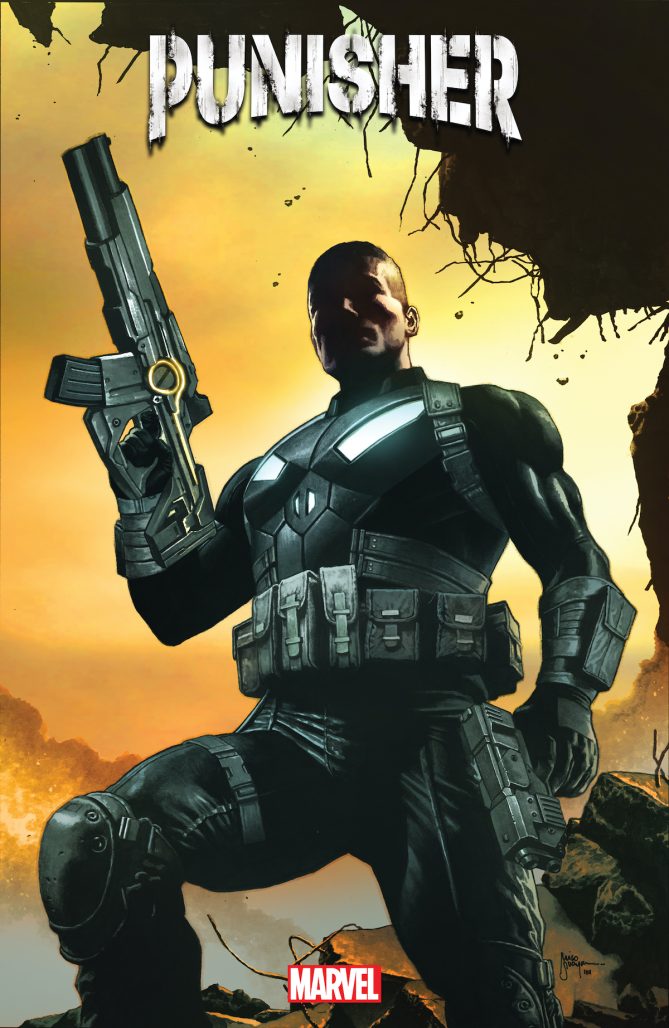
Also, watching Joe evolve, even over the course of our opening arc. It kind of surprised me, because everybody’s used to seeing The Punisher as such a stoic character. I don’t think we’re ever going to have a Punisher who’s super in-touch with his feelings. But I do think that Joe is thoughtful, and watching his mission evolve, even over the course of the origin, it kind of snuck up on me too, but I think that winds up being coming the emotional heart of the book. He’s the person who did bad things and stopped doing those bad things, and now those bad things have sort of been unearthed again, and is there a way that he can kind of channel that, if not for the greater good, maybe for the good of people who need help?
And I’m also very excited for people to see these villains. Especially after the opening arc, there are a lot of brand-new villains that I’ve pitched to Marvel, and so far the response has been pretty receptive, so honestly, it’s just a matter of how many of them can I get in the book before, well, before we get to something even bigger. We’ve got some really fun stuff planned in our opening arc and beyond, andI can’t wait for people to get to read it.
Published by Marvel Comics, The Punisher #1 is out in stores and digitally this Wednesday, November 8th.


